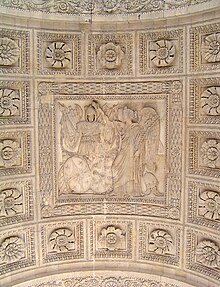Arc de Triomphe du Carrousel
| Arc de Triomphe du Carrousel | |
|---|---|
Pierre François Léonard Fontaine |
The Arc de Triomphe du Carrousel (pronounced
Description



The monument is 63 feet (19 m) high, 75 feet (23 m) wide, and 24 feet (7.3 m) deep.
- the Arms of the Kingdom of Italy with figures representing History and the Arts
- the Arms of the French Empire with Victory, Fame, History, and Abundance
- Wisdom and Strength holding the arms of the Kingdom of Italy, accompanied by Prudence and Victory.
Napoleon's diplomatic and military victories are commemorated by bas-reliefs executed in rose marble. They depict:
- the Peace of Pressburg
- Napoleon entering Munich
- Napoleon entering Vienna, sculptor Louis-Pierre Deseine
- the Battle of Austerlitz, sculptor Jean-Joseph Espercieux
- the Tilsit Conference
- the surrender of Ulm, sculptor Pierre Cartellier
The arch is derivative of the triumphal arches of the Roman Empire, in particular the
The upper frieze on the entablement has sculptures of soldiers: Auguste Marie Taunay's cuirassier (left), Charles-Louis Corbet's dragoon, Joseph Chinard's horse grenadier and Jacques-Edme Dumont's sapper.
The quadriga atop the entablement is a copy of the so-called Horses of Saint Mark that adorn the top of the main door of the St Mark's Basilica in Venice but during both French empires the originals were brought up for special occasions.[clarification needed]
History

Designed by
It was originally surmounted by the
The Arc du Carrousel inspired the design of Marble Arch, constructed in London between 1826 and 1833.[3]
Geography
The Arc de Triomphe du Carrousel is at the eastern end of Paris Axe historique ("historic axis"), a nine-kilometre-long linear route which dominates much of the northwestern quadrant of the city.
Looking west, the arch is aligned with
References
- ^ "Arc de Triomphe du Carrousel". 3 June 2013.
- ^ Lynnise Phillips – Pomona College; USA: "Paris Pages; Monuments; Arc de Triomphe du Carrousel". Archived from the original on 2008-12-30. Retrieved 2008-12-28.
- ^ Exploring London : Marble Arch
External links
- Official website
 (in French)
(in French) - Arc de Triomphe du Carrousel at Structurae
- Arc de Triomphe du Carrousel at Napoleon.org
